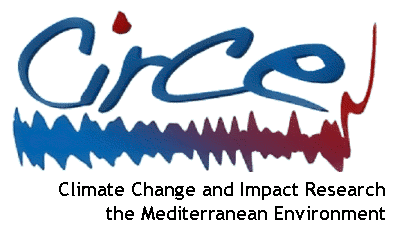

The Atmospheric Modeling and Weather Forecasting Group of the University of Athens and its Institute of Accelerating Systems (IASA) is leading the Researh Line 8 (RL-8). The RL leader is Prof. George Kallos and co-RL leader is Prof. Zev Levin.
Description of the Work
Rationale: The Mediterranean Region has some unique characteristics concerning the regional atmospheric circulation, regional climate and therefore air quality. The general pattern of the atmospheric circulation in the Mediterranean region is from North or Northwest to South or Southeast. This is due to differential heating between the land of North Africa and Southern Europe and the Mediterranean waters in between. This results in transport of air pollutants from Europe towards the Mediterranean Region, Northern Africa and the Middle East (Kallos et al. 1997, 1999, Millan et al., 1997). Large scale subsidence over Mediterranean waters has as a result the dominance of dry conditions during the warm period of the year. During the cold period of the year the cyclogenetic activity dominates. The characteristic scales of air pollution transport are ranging from 2 to 4 days depending on the synoptic and mesoscale conditions in the region as well as the strength of pressure gradient between the Atlantic anticyclone and the monsoonic low activity over the Middle East and the Indian Ocean (Kallos et al., 1993; 1997; 1999; Millan et al., 1997). Due to the dominance of the clear sky conditions for long periods in the Mediterranean region photochemical activity is considerable at all scales (Kallos et al., 1997, Balis et al., 2002; Zerefos et al., 2002; Kouvarakis et al., 2002).
O3 and PM formation and transport are key issues in the region (Luria et al. 1996). In addition to this air pollution transport and transformation activity the uptake, transport and deposition of Saharan dust towards the Mediterranean region and Europe is an important factor that contributes significantly in air quality degradation, ecosystems and water management (Rodriguez et al., 2001; Oszoy et al, 2001; Levin et al., 1996; Givati and Rosenfeld, 2004, Kallos et al., 2006). This is a major factor that affects air quality in the region to such extend that many areas and cities cannot meet the imposed EU regulations (Rodriguez et al., 2001; WHO, 2003). The water budget in the Mediterranean region is in a critical balance and is a critical issue because it affects hundreds of millions of people and a fragile ecosystem.
The impacts of the PM and mineral dust on the water budget and radiative transfer are very complicated and can affect them in various ways (Nickovic et al., 2001, Oszoy et al., 2001, Kallos et al., 2006). It can lead to the warming of mid tropospheric layers and cooling of the surface and therefore suppress precipitation, it can reduce precipitation due the high amounts of CCNs (Rosenfeld, 2000; Levin et al., 2005) but it can lead to the appearance of heavy rainfall due to the formation of giant CCNs (Levin et al., 2005). Such giant CCNs can be formed in wet environment due to the coexistence and interactions of anthropogenically-produced pollution particles and natural particles such as sea salt and mineral dust.
Current status of knowledge: The current status of knowledge concerning the air pollution scales and paths of transport in the Mediterranean region is at relatively high level. Despite this fact the links to critical details described above and especially these with the climate and its variability need further analysis and a multi-scale and interdisciplinary approach. The existing records of air quality and climatic data are considered as sparse and mainly collected during past experimental campaigns.
The existing modelling tools that can be used for studying air pollution ? climatic interactions and impacts are capable to analyse regional climatic and air pollution conditions of the Mediterranean region but they lack an integrated approach and feedback with the global scale climatic and air pollution changes.
In order to achieve the imposed objectives an interdisciplinary approach is adopted. The proposed methodology includes the creation of a database containing current and future emission scenarios, past and future observations of air pollutants (surface, upper air, radiation, remote sensing etc), the development of a new generation integrated modelling system that will contain the necessary links between the various physico-chemical processes taking place and finally, perform limited area case studies analysis and climatic-type model simulations that will test the control strategies